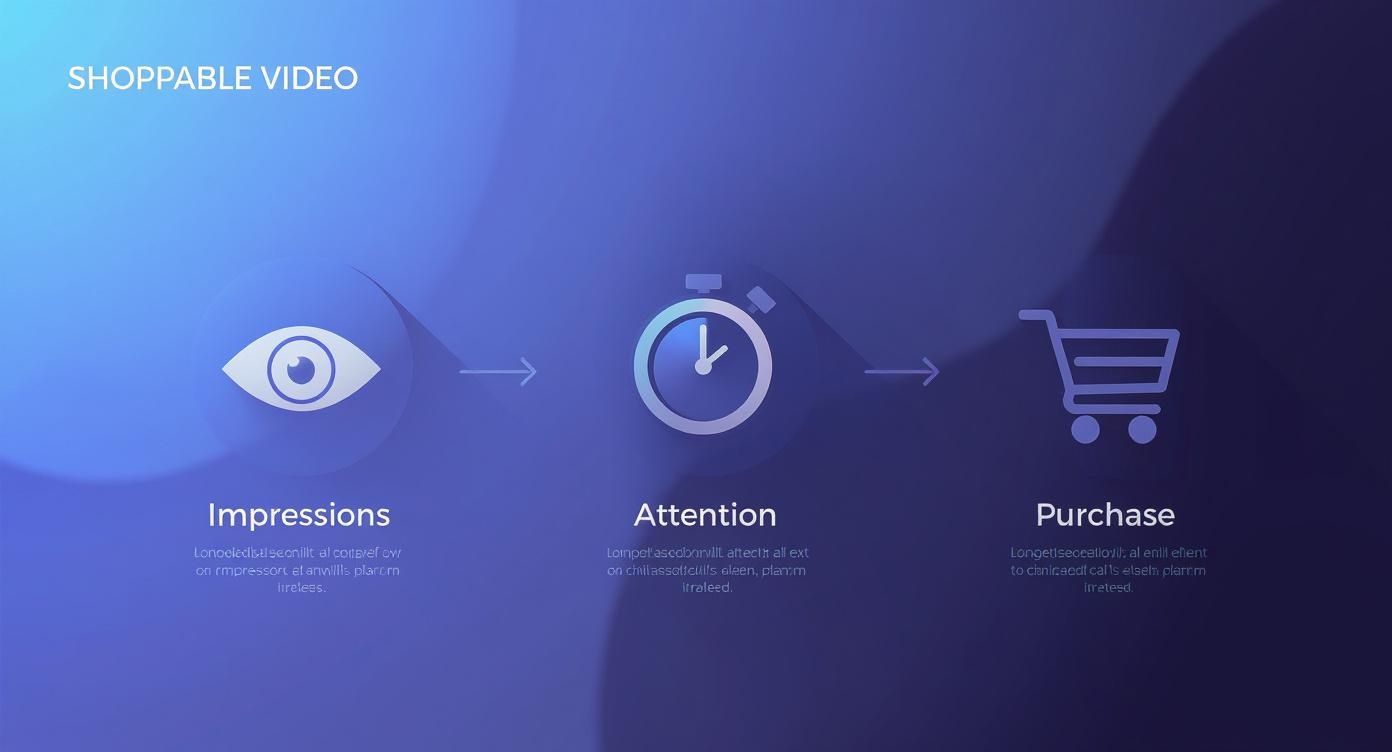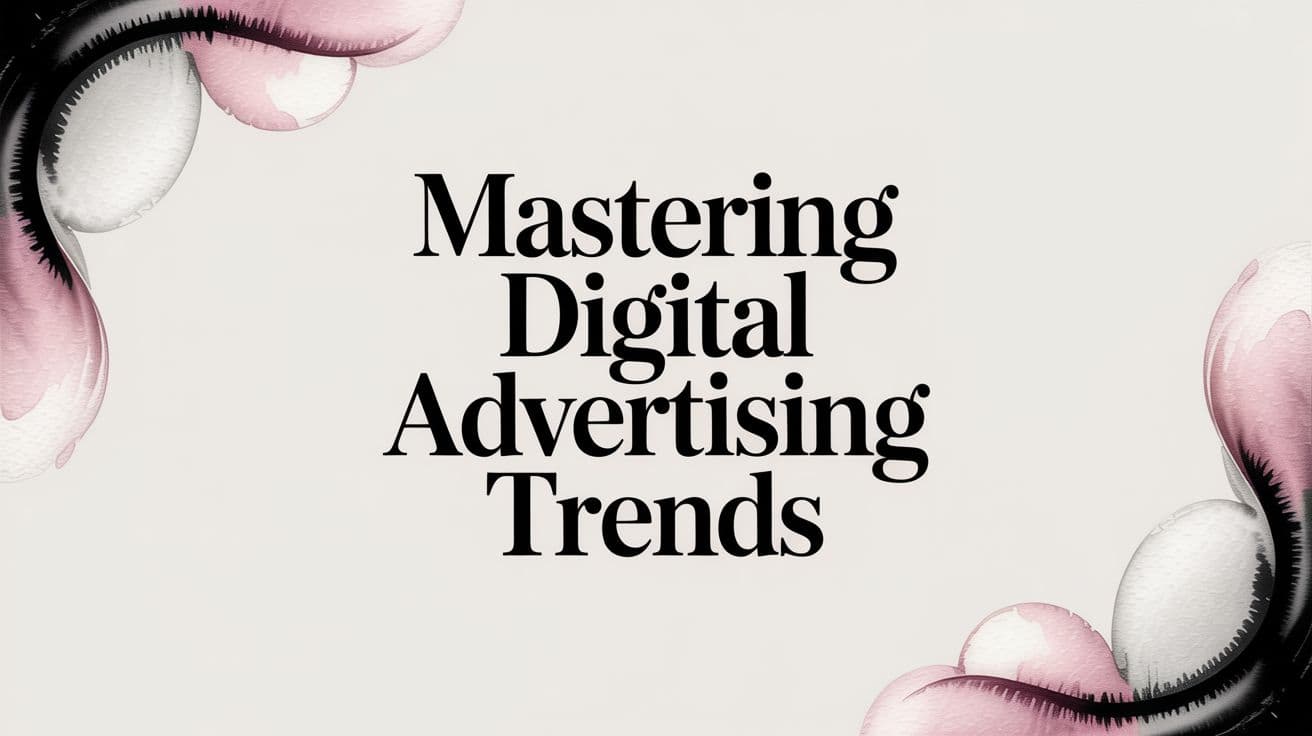The ground is shifting under our feet in digital advertising, and it’s happening faster than ever before. This isn't just another year of small tweaks; we're in the middle of a total reinvention. The most impactful digital advertising trends are all circling around a few core ideas: privacy-first targeting, the explosion of Connected TV (CTV), and AI-driven personalization. Getting a handle on these forces isn't just important—it's essential for survival.
The New Rules of Digital Advertising

The advertising world is being reshaped by two massive forces: consumers demanding more privacy and the non-stop emergence of new media channels. This isn't just a blip on the radar; it's the new normal for how brands have to connect with people. The old playbook of tracking users across the web with third-party cookies? It’s basically obsolete.
This new reality is both a massive challenge and an incredible opportunity. Marketers who get on board will discover far more authentic ways to engage their customers, building real trust and loyalty along the way. Those who stick to the old ways are going to get left behind.
Core Forces Driving Change
This whole evolution isn't happening by accident. It’s being pushed forward by a handful of key developments that every publisher, e-commerce manager, and ad sales team needs to understand inside and out. Once you grasp these foundational shifts, the specific trends shaping the industry start to make a lot more sense.
Here are the big drivers:
- The Privacy-First Internet: People and regulators are demanding more say over their personal data. This has led to the death of the third-party cookie and put a huge emphasis on building solid first-party data strategies.
- The Rise of New Channels: The living room is the new advertising battleground thanks to the incredible growth of Connected TV (CTV). At the same time, short-form video on social media is capturing an enormous amount of user attention.
- The AI Creative Revolution: Artificial intelligence has moved from a futuristic concept to a practical, everyday tool. It's now used to generate endless ad variations, personalize content for millions of individuals, and optimize campaigns on the fly.
This guide is your roadmap to the most important digital advertising trends in the market today. We’re going to cut through the buzzwords and give you actionable insights and real tactics you can use. For an even deeper dive, you might also want to check out our analysis of 2025 advertising strategies and insights.
The scale of this industry-wide change is backed by some serious financial momentum. In 2025, global ad spending is on track to cross the $1 trillion mark for the very first time—a massive milestone that puts the stakes and the opportunities into perspective.
To put that number in context, it represents a doubling of ad spend since just 2016. It shows just how quickly money is moving toward these new, more effective methods of advertising. You can explore the full breakdown of global ad spend statistics for 2025.
How to Succeed in a Cookieless World

The impending death of the third-party cookie isn't just some minor tech update; it's a fundamental rewiring of how brands connect with people online. For years, we’ve all relied on these digital breadcrumbs to follow users across the web, but that model is officially broken. This isn’t a disaster, though. It’s a huge opportunity to build stronger, more authentic customer relationships.
Think about it like this: using third-party data was like renting a stranger's address book. Sure, you had a list of names and could send them mail, but you had no real relationship or context. First-party data, on the other hand, is your own, carefully curated contact list—people who chose to give you their information because they actually trust your brand.
This move from renting data to owning it is the core trend separating the brands that will thrive from those that will struggle. The spotlight is now squarely on building your own valuable, consented data assets directly from your audience.
Building Your First-Party Data Foundation
So, how do you start building your own address book? The secret is offering genuine value in exchange for information. You’re not just begging for an email; you're starting a conversation and creating an experience that makes people want to connect with you.
This means shifting your strategy toward engaging, interactive content and crystal-clear value propositions. That old "subscribe to our newsletter" pop-up just doesn't cut it anymore. Today's strategies have to be much more creative and focused on the user.
Here are a few powerful ways to gather first-party data:
- Interactive Quizzes and Polls: Create fun, genuinely helpful quizzes related to your industry. A skincare brand, for example, could build a "Find Your Perfect Skin Routine" quiz that delivers personalized advice right to a user's inbox.
- Exclusive Content and Gated Resources: Offer up your best stuff—in-depth reports, webinars, or e-books—in exchange for contact details. This not only positions you as an expert but also attracts a highly motivated and relevant audience.
- Loyalty and Rewards Programs: Give customers a real reason to create an account. Exclusive discounts, early access to new products, or a simple points system can foster incredible long-term loyalty while providing rich behavioral data.
The goal is to make data collection feel like a natural part of a great user experience, not an intrusive transaction. When a customer willingly shares their information, the data you get is not only privacy-compliant but also wildly more accurate and valuable for personalization.
Navigating the Next Wave of Targeting
As third-party cookies fade into the background, a new generation of privacy-first targeting technologies is stepping up to fill the void. These methods make it possible to deliver relevant advertising without creepy cross-site tracking, a crucial evolution in today's digital advertising trends.
Getting a handle on these new tools is non-negotiable for any modern ad strategy. They represent the future of reaching audiences at scale while respecting their privacy. Let's look at two of the most important ones.
Data Clean Rooms Think of these as a secure digital "meeting room." It's a space where two or more companies can bring their anonymized first-party data together for analysis, but neither side ever sees the other's raw customer lists. For instance, a retailer and a publisher could collaborate in a clean room to measure campaign effectiveness and understand audience overlap without ever sharing personally identifiable information.
Advanced Contextual Advertising This is so much more than basic keyword matching. Modern contextual targeting uses AI to analyze the entire context of a webpage—the text, the images, even the video sentiment—to place ads in environments that are truly relevant. It’s all about reaching an engaged audience at the exact moment they’re actively consuming content on a specific topic. You can see how this fits into the larger automated ecosystem in our complete guide to programmatic advertising.
Ultimately, success in a cookieless world comes down to a two-part strategy: build your own rich, first-party data assets, and get smart about using these next-generation, privacy-safe technologies to reach new audiences.
Winning with CTV and Short-Form Video
Today’s video advertising world is split between two massive, and seemingly opposite, forces. On one side, you have the big-screen, lean-back experience of Connected TV (CTV). On the other, the fast-paced, lean-in world of short-form social video. A smart strategy doesn't pick a side—it masters both.
To really get why CTV is such a big deal, you have to understand programmatic advertising. Picture an automated stock market, but instead of buying and selling shares, it’s buying and selling ad space. Advertisers plug in their budget and who they want to reach, and algorithms bid on available spots across thousands of apps and sites in the blink of an eye.
This is the engine that blew the doors open for primetime TV advertising. What used to be a playground exclusively for massive corporations with seven-figure budgets is now accessible to almost anyone through CTV.
The Rise of CTV Advertising
Connected TV is basically any television that gets online to stream video. Think smart TVs or devices like a Roku, Apple TV, or Amazon Fire Stick. For advertisers, this is a game-changer. It blends the high-impact storytelling of a classic TV commercial with the sharp targeting and measurement we expect from digital marketing.
Instead of dropping a ton of money on a single ad slot during a hit show and just hoping the right people are watching, programmatic tech lets you serve your ad directly to households that match your ideal customer profile. A local furniture store can now run a commercial on the same big-name streaming services as a global brand, but they only pay when their ad reaches people in their actual service area.
That kind of efficiency is why we're seeing huge investment here. Global ad spend forecasts point to sustained growth in digital and streaming, with the Americas expected to lead with a 6.3% increase and the Asia-Pacific region close behind at 5.8%. You can dig deeper into the numbers with Dentsu's analysis of regional advertising growth trends.
CTV advertising delivers the best of both worlds: the prestige and attention of the big screen combined with the data-driven intelligence of digital. It’s a powerful way to build brand awareness with a captive audience.
Mastering Short-Form Social Video
While CTV owns the living room, short-form video on platforms like TikTok and Instagram Reels absolutely dominates on the go. The mindset for creating content here is completely different. These platforms are all about authenticity, speed, and what’s trending right now.
That polished, 30-second spot that looks amazing on a 65-inch TV? It will probably feel jarring and get swiped away in a heartbeat on a social feed. Success here demands a different playbook.
- Be Authentic: People want content that feels like it belongs on the platform. That often means less polish, more personality, and a creator-led, behind-the-scenes vibe.
- Hook Them Fast: You have maybe three seconds to stop the scroll. Start with a bold visual, a provocative question, or something totally unexpected.
- Jump on Trends: Using trending sounds, formats, and challenges is your ticket to getting seen. It shows you’re part of the conversation, not just shouting into it.
The most effective video strategies don’t treat these two channels as an either/or. They create a powerful one-two punch that works together.
Video Advertising Channels Comparison
To succeed, you need to know when to use the right tool for the job. CTV is your heavyweight for building brand authority, while short-form social video is your agile-and-fast champion for driving immediate engagement. This table breaks down their core differences and strategic roles.
| Attribute | Connected TV (CTV) | Short-Form Social Video |
|---|---|---|
| Viewing Environment | "Lean-back" on a large screen, often with others. | "Lean-in" on a mobile device, typically a solo experience. |
| Audience Mindset | Relaxed, focused, and receptive to storytelling. | Fast-paced, seeking quick entertainment or information. |
| Ad Format | Longer-form (15-60 seconds), non-skippable, high production value. | Very short (3-15 seconds), skippable, often user-generated feel. |
| Creative Approach | Cinematic, narrative-driven, brand-focused. | Authentic, trend-driven, direct-to-camera, value-first. |
| Key Objective | Brand awareness, reach, building brand equity. | Engagement, community building, driving clicks, conversions. |
In the end, it’s about creating a connected experience. Use the high-impact, targeted reach of CTV to build broad brand recognition and tell your bigger story. Then, use the authentic, fast-paced nature of short-form video to build a community, engage with your audience personally, and drive them to take action. Together, they make sure you’re capturing attention no matter where, or how, people are watching.
AI-Powered Creative: Your New Unfair Advantage

Artificial Intelligence has officially moved out of the lab and into the marketing department. It's no longer just a buzzword; it's a practical, powerful tool that’s changing how we think about, create, and test ad creative. This shift is one of the biggest digital advertising trends happening right now, taking AI from industry hype to everyday reality.
Think of it as having a creative co-pilot. While you focus on big-picture strategy and understanding your audience's quirks, AI handles the heavy lifting of data analysis and rapid-fire iteration. It can spit out dozens of ad copy variations for A/B testing or automatically customize a video for thousands of different audience segments. This lets your team do what they do best—be creative and strategic.
Generative AI: From Blank Page to Instant Ideas
Generative AI has completely flipped the script on creative production. The dreaded blank page is a thing of the past. Now, marketers have tools that can generate a whole spectrum of creative assets in seconds, from compelling ad copy and headlines to video scripts and even early visual mockups.
This is a massive boost for efficiency. A recent survey showed that 44% of marketers are already using machine learning to produce campaign assets and tweak creative on the fly. This isn't about replacing human ingenuity; it's about amplifying it. By automating the repetitive grunt work, tools like dedicated software with AI ad copy generators give your team a richer set of ideas to work with and refine.
This new workflow means you can test more concepts, way faster. Instead of spending days crafting just a few ad versions, AI can deliver a dozen in minutes, giving you a huge leg up on learning what actually works.
Generative AI tackles the initial grind of content creation, freeing up creative teams to focus on strategic refinement instead of routine production. This speeds up everything, from brainstorming all the way to launch.
Dynamic Creative Optimization: Personalization on Autopilot
If generative AI is about creating the ingredients, Dynamic Creative Optimization (DCO) is the master chef that puts them together for the perfect, personalized meal. DCO is a type of ad technology that builds ads in real-time, pulling from user data to create a unique version for every single person who sees it.
Imagine you're running a single video ad campaign. You want to reach people in different cities, with different interests, at different points in their customer journey. Creating a unique video for every possible combination manually? Forget it. It's impossible.
DCO makes it possible by breaking an ad down into its building blocks and reassembling them on the fly. Here's how it works:
- The Components: An ad is deconstructed into its core parts—headlines, background videos, calls-to-action (CTAs), product images, voiceovers, you name it.
- The Data Feeds: The system then looks at data sources like the viewer's location, the local weather, their browsing history, or even items they left in a shopping cart.
- The Real-Time Assembly: Right before the ad is served, the DCO platform instantly puts together the most relevant version. Someone in sunny Miami might see a video with a beach background, while a user who abandoned their cart sees an ad for that exact product, maybe with a small discount to sweeten the deal.
This kind of hyper-personalization used to be a logistical nightmare. Now, AI makes it a smooth, automated process. It’s a game-changer for modern campaigns, allowing brands to speak to individuals with incredible relevance, which naturally drives up engagement and conversion rates.
By bringing AI into your workflow, you can finally shift from a one-to-many broadcast model to a truly one-to-one conversation. This doesn't just improve your numbers; it builds a stronger connection with your customers by showing them you get what they need. To dive deeper into this, check out our ultimate guide to artificial intelligence in advertising.
Turning Attention into Action with Shoppable Video
For years, the path from seeing a great video ad to actually buying the product was a clunky, multi-step ordeal. A viewer might love what they see, but then they’d have to open a new browser tab, hunt for the brand, find the exact item, and then finally get to checkout. Every single step was a potential exit point.
That's precisely the problem shoppable video solves. It collapses that entire customer journey into a single, elegant interaction. Instead of just passively watching, viewers can actively shop, clicking and buying products directly from inside the video player. It's like turning every frame into its own little storefront, closing the gap between "I want that" and "I bought that" in an instant.
This isn't just a minor tweak for convenience—it represents a massive shift in how we think about viewer engagement. The old ad world was obsessed with vanity metrics like impressions, which only tell you if an ad loaded on a page. Today, the real currency is something much more valuable: attention.
The New Currency is Attention
An impression is a hollow metric. It can't tell you if anyone actually watched your ad, understood the message, or felt any connection to your brand. Attention metrics, on the other hand, measure what really matters: how long people watch, whether they interact, and if they click on specific elements.
That's a critical difference. A single, 30-second engaged view from an interested customer is worth infinitely more than a thousand fleeting glances from people scrolling past. Quality of engagement now completely overshadows the sheer quantity of views. For anyone looking to turn passive viewers into active buyers, understanding how search and shopping video ads are reshaping the game is a must.
In this new environment, attention isn't just something you hope for—it's a measurable asset you have to earn and cultivate. The brands that win are the ones who can capture high-quality attention and then give viewers an immediate way to act on it.
Shoppable video is the perfect format for this new reality. It’s designed to both grab attention and convert it into a sale, all within the same seamless experience.
How Shoppable Video Works in Practice
The technology powering shoppable video isn't some far-off concept anymore; it's being integrated directly into the platforms we use every day. It’s quickly moving from a novel trick to a core part of any modern e-commerce and advertising playbook.
Here’s a typical user journey:
- Engagement: A viewer is watching a video—maybe a vlogger reviewing a new camera or a clothing brand showing off its latest collection.
- Interaction: As a product appears, a subtle, interactive element pops up. It could be a small "Shop Now" button, a highlighted icon, or a clickable hotspot over the item itself.
- Conversion: The viewer clicks. This might open an overlay with product details, add the item to a cart right inside the video player, or take them straight to checkout—often without ever leaving the social feed or website they were on.
This creates a powerful and contained loop. The ad doesn't just build awareness; it becomes a point of sale. One study found that interactive video ads can increase the time a viewer spends with a brand by a whopping 47% compared to standard, non-interactive ads. That extra time is a golden opportunity to build a connection and drive a purchase, right when a customer's interest is at its absolute peak.
Putting These Trends Into Action With Video Automation
Knowing about these big shifts in digital advertising is one thing. Actually doing something about it? That’s where the real work begins. This is the gap between theory and execution, and it’s where a solid video automation platform like Aeon can turn these challenges into your biggest strengths.
Think about it: instead of your team painstakingly crafting a few video ads by hand, automation lets you create a nearly endless stream of personalized versions built for the cookieless era. You just connect a simple data source, and suddenly you can generate unique videos for different audience segments, cities, or even specific promotions. It’s a direct answer to the need for more creative firepower in a privacy-first world.
Scaling Creative For Today's Ad Channels
The hunger for fresh content on platforms like CTV and TikTok is insatiable. A single, high-production video ad just doesn't cut it anymore. Video automation is the only practical way to keep up, letting you produce creative at a scale that makes serious A/B testing and optimization possible.
Imagine instantly generating hundreds of ad variations—each with a different hook, call-to-action, or music track. This lets you find out what really connects with your audience on each specific platform, all without burning out your creative team.
The real magic of automation is that it lets you shift from a one-to-many to a one-to-one advertising model, even if you don't have a massive team. You can finally deliver the right video message, to the right person, at the right time—every time.
Turning Your Entire Catalog Into Shoppable Videos
Shoppable video is a massive opportunity to shrink the path to purchase. But the idea of producing interactive videos for every single product in your catalog probably sounds overwhelming. This is where automation completely changes the game, allowing you to mass-produce shoppable video ads that drive sales directly.
This journey map shows just how simple and powerful the experience is, moving a customer from a casual glance to a confident purchase.

As you can see, this format closes the gap between grabbing someone's attention and turning that interest into a sale. A platform like Aeon can automatically pull from your product feed to overlay pricing, details, and "buy now" buttons onto video templates. Just like that, your entire product line becomes a library of interactive, shoppable videos. It’s how smart brands are converting fleeting moments of attention into real revenue.
Your Questions on Digital Advertising Answered
Stepping into the new era of digital advertising brings up plenty of practical questions. We've pulled together some of the most common ones we hear from marketers, publishers, and e-commerce managers, along with clear answers to help you shape your strategy.
How Can a Small Business Collect First-Party Data?
For a small business, building a first-party data strategy doesn't have to break the bank. It all comes down to a simple value exchange: give people something useful, and they'll be more willing to share their information. It’s about moving beyond a basic "subscribe" pop-up and creating genuinely engaging experiences.
Here are a few tactics that work incredibly well:
- Run a Quiz or Calculator: Build a simple, interactive tool that actually solves a problem for your audience. A local financial advisor, for instance, could offer a "Retirement Savings Calculator" and then collect an email to send the personalized results.
- Host an Exclusive Webinar: Share what you know in a live online event. This approach pulls in a highly interested audience and gives you a perfectly natural reason to ask for contact details during registration.
- Offer a Loyalty Program: It can be as simple as a digital punch card or giving members early access to sales. These perks encourage customers to create an account, which in turn gives you valuable purchase history and preference data.
The whole point is to weave data collection into the customer experience so it feels helpful, not intrusive.
What Is the Best Way to Measure CTV Campaign ROI?
Measuring the return on your Connected TV (CTV) ad spend is thankfully a world away from the guesswork of old-school television. Instead of relying on broad estimates, you can now use digital-style metrics to see exactly how a campaign is impacting your business.
The key is to focus on metrics like website lift—how many people visited your site right after seeing an ad—and conversion tracking, which connects ad views directly to online actions like a purchase or a sign-up. A simple but effective trick is to use unique promo codes that you only mention in your CTV ads. This allows you to attribute sales directly, linking your big-screen presence to real business results.
A question that comes up a lot is, "Will AI replace human creativity in advertising?" The answer is a firm no. There’s a saying floating around the industry: AI won't take your job, but a person who knows how to use AI will. Think of AI as an incredibly powerful co-pilot, not the pilot. It's brilliant at handling the repetitive, data-heavy lifting, like generating hundreds of ad variations for A/B testing or personalizing content for thousands of users at once. This frees up human marketers to focus on what we do best: high-level strategy, creative thinking, and understanding the emotional nuances that build a brand people actually care about.
Ready to put these trends into practice? Aeon's video automation platform is built to help you scale your creative production for CTV, social media, and shoppable video. We turn today's biggest advertising challenges into your most powerful advantages.
See how it works at the Aeon website.
